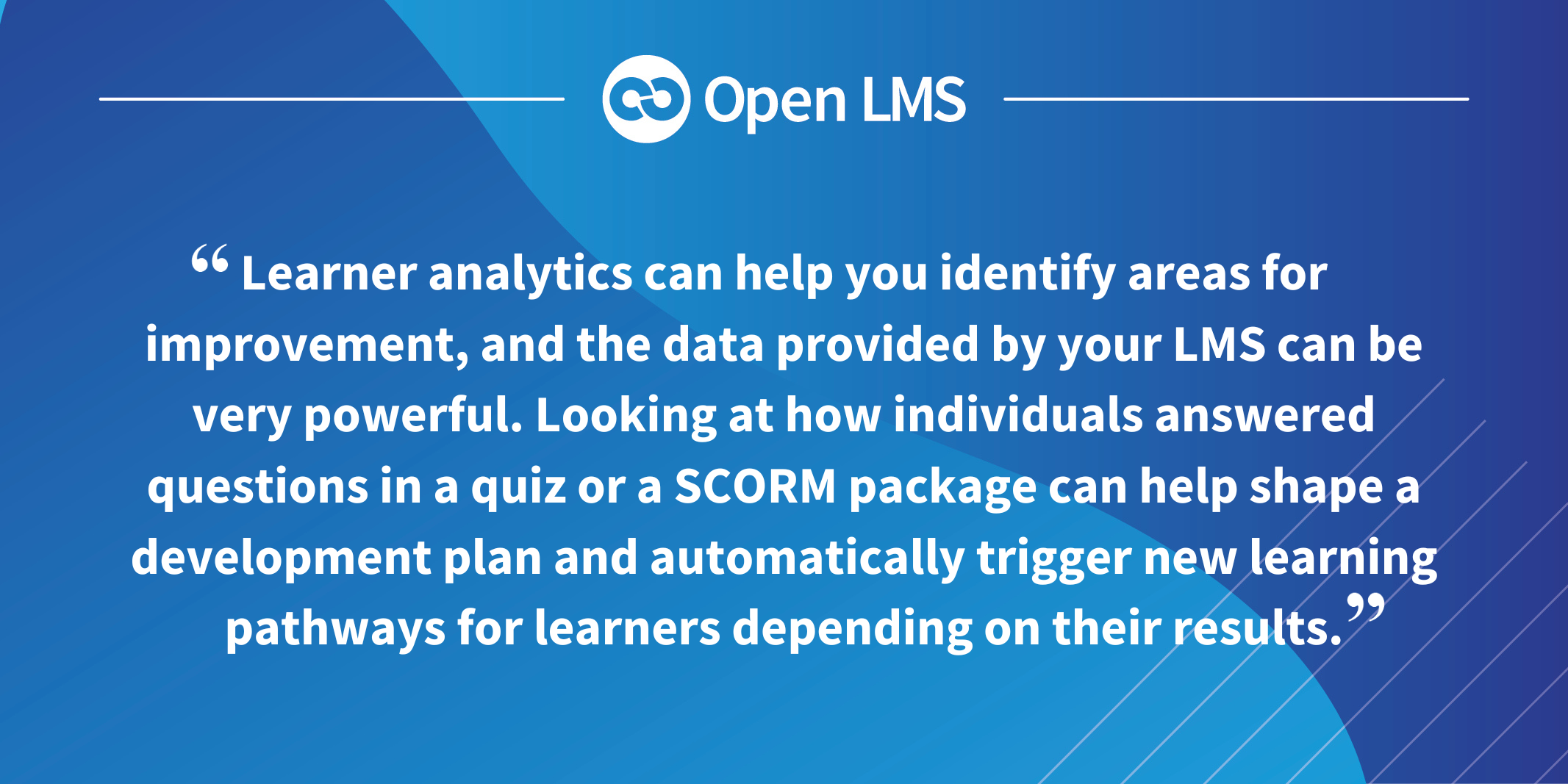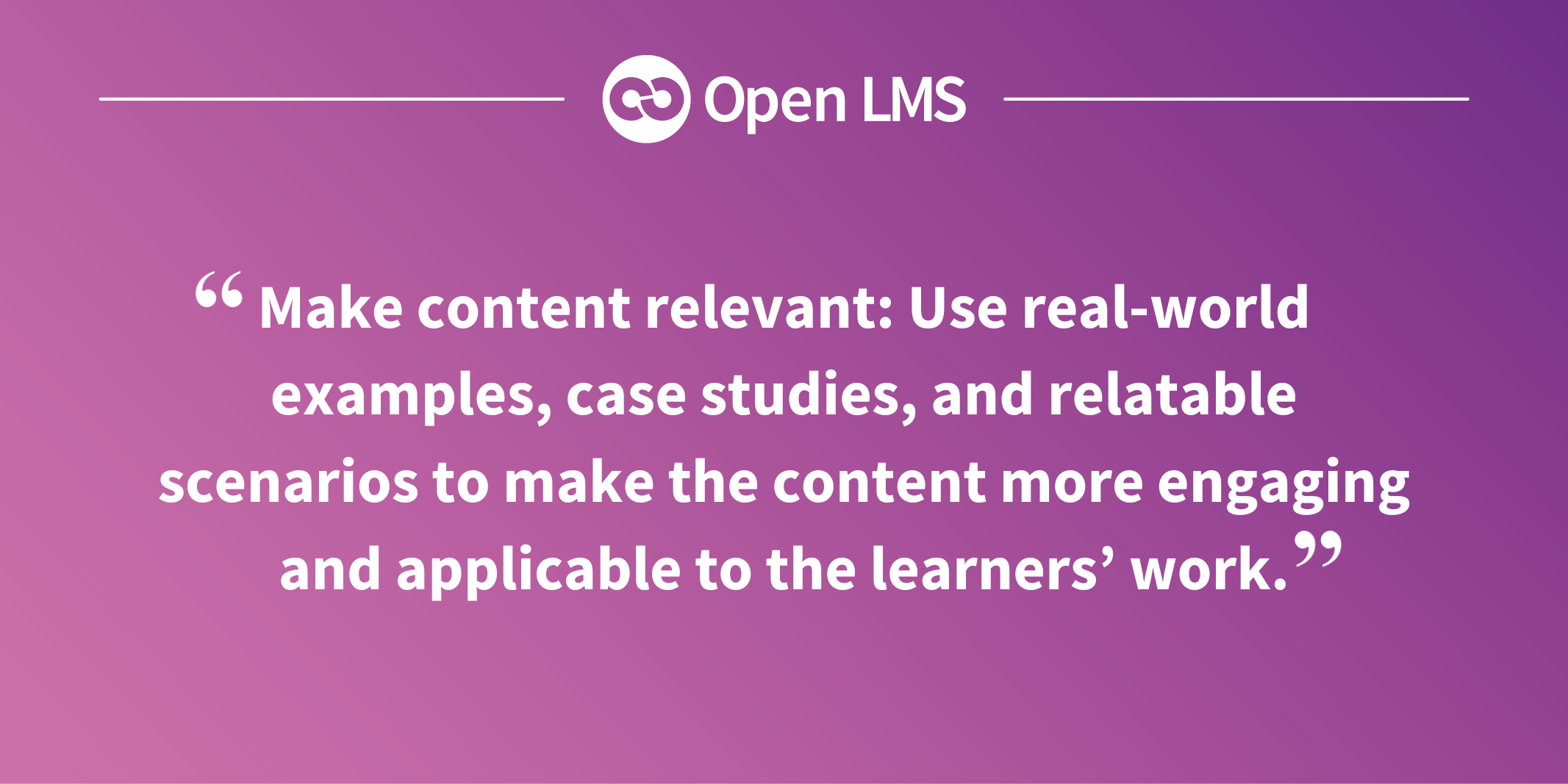How to Create and Track Customized Training Programs With Your Corporate LMS
It doesn’t matter just how slick, snazzy, or content-rich your LMS is if you can’t determine whether it’s effective at helping you achieve your learning goals. Improving the performance of your sales team, enhancing your safety protocols, and developing your future leaders requires high-impact training programs that keep your employees engaged and motivated to learn new skills.
Without understanding the impact of both your formal and informal learning initiatives, it can be challenging to articulate the value of your training programs and how they’re impacting outcomes. That’s why it’s imperative that your LMS is supported by data tracking and evaluations that can establish whether your learning and development targets are being met.
Keep reading to find out how. Plus get seven quick tips for creating engaging training content and read two mini case studies to see how other organizations use LMS data to enhance their strategies.
5 Effective Ways to Track Training Data in Your LMS
Keeping track of learning targets means collecting a significant amount of data on your learners and training programs, but it’s not just about gathering information. You also have to understand what that data means. You can track data in your LMS with:
1) Basic Reporting
Any LMS worth its salt should come with at least some basic reporting tools that provide an initial understanding of the actions being taken in the learning platform. Out-of-the-box Moodle™-based LMS, for example, quickly and easily shows platform access and program usage reports. This can be at the site, course, and activity level. Activity analytics should be the bare minimum of the reports available to instructors within the LMS. These simple reports can help achieve greater participation and lead to conversations that resolve important issues, such as course access and task completion rates.

RELATED READING | ‘The Benefits of Migrating From Moodle™ to Open LMS as Your Open-Source eLearning Provider’
2) Custom Reports
The basic reports mentioned above provide feedback on very general training data, such as whether the user logged in or whether they completed a certain activity. Unfortunately, they often don’t (or can’t) give you the answers to more specific questions like:
- How much time did a learner spend completing a quiz?
- What order was a set of activities performed in?
- When was the precise moment a learner stopped watching a webinar?
While it’s certainly possible for an out-of-the-box platform to include reporting for some of these things, a hosting partner like Open LMS can offer basic reporting tools in addition to custom reports that filter information by department, job role, or any other metric you choose. For example, the Open LMS-exclusive Open Reports Engine (ORE) gives you granular insights into your learning programs and turns data into easily digestible visualizations that help you make informed decisions to further your mission and reach your goals.
DIVE DEEPER INTO ORE | ‘Put Your Data to Work With the New Open Reports Engine’
3) Course Evaluations
Learner analytics can help you identify areas for improvement, and the data provided by your LMS can be very powerful. Looking at how individuals answered questions in a quiz or a SCORM package can help shape a development plan and automatically trigger new learning pathways for learners depending on their results.
This data is also instantly available to instructors to ensure that the initial materials and resources used are fulfilling the requirement of the course specification. This is especially vital for ensuring regulatory compliance content is effective or sales training genuinely impacts performance, for example.
READ A REPORTING CASE STUDY | ‘How Continence Health Australia Manages Its Critical Reporting Requirements With Open LMS’
4) Scheduled Reports
Having access to all these reports is great, but what about having them triggered at certain times? And sent to the right people? The answer to that is scheduled reports! An LMS with easy-to-use scheduling options allows decision-makers to see specific information without needing to log in to the learning platform. Several plugins are available in Open LMS to streamline reporting and ensure data safety and integrity.
RELATED READING | ‘How Open LMS’s Rigorous Approach to LMS Plugins Provides Security, Compliance, and Partnership’
5) Third-Party Reporting Tools
To take your LMS data reporting that step further, Open LMS has a long list of partners that we can introduce you to that will help meet your needs when it comes to reporting, analytics, and other solutions to effectively track training within your LMS.
One great example is IntelliBoard. With this product, you’ll be immersed in a world of real-time reports, dashboards, graphs, and KPIs—all driven by the data obtained through your LMS. Effectively tracking and making data-driven decisions from the training data in your LMS is essential to delivering engaging and future-proofed learning programs for your organization.
Want to see Open LMS in action? Take a self-guided tour or request a custom demo.
How to Use a Corporate LMS to Create Customized Training Programs for Different Teams or Departments
Follow these six steps to create customized training programs using an LMS:
- Define the learning objectives for each team or department based on their specific job requirements and training needs.
- Choose appropriate learning content, such as videos, presentations, quizzes, and assessments, to meet those objectives.
- Create separate training modules or courses in the LMS for each team or department.
- Assign specific training modules or courses to each team or department based on their learning objectives.
- Set up a system to track and report on each team's or department's progress, including completion rates and test scores.
- Continuously evaluate and update the training programs as needed, based on feedback and performance data.
Note: The specific steps and features may vary depending on the LMS you use, so be sure to familiarize yourself with your platform's capabilities.
HANDPICKED FOR YOU | ‘Online Learning That Works! 5 Strategies for Success’
7 Tips for Creating Engaging and Effective Training Content
Ensure your learning programs keep learners focused, engaged, and ready to achieve positive outcomes with the following tips:
- Make content relevant: Use real-world examples, case studies, and relatable scenarios to make the content more engaging and applicable to the learners' work.
- Keep it interactive: Use a mix of multimedia elements, such as videos, images, animations, and gamification, to keep learners engaged and prevent boredom.
- Make it bite-sized: Break down complex information into smaller, manageable chunks to reduce cognitive overload and improve retention.
- Use storytelling: Incorporate storytelling elements, such as plot, characters, and conflict, to help learners understand and remember the content.
- Encourage active learning: Provide opportunities for learners to practice and apply what they have learned, such as through simulations, scenario-based exercises, or hands-on activities.
- Assess regularly: Regularly assess learners' understanding of the content through quizzes, assessments, and interactive activities to gauge their progress and provide feedback.
- Foster collaboration: Encourage collaboration among learners, such as through discussion forums, peer feedback, or group projects, to promote peer learning and community building.
WATCH THIS CUSTOMER SUCCESS STORY | ‘How Middlesex University Leverages Open LMS to Manage Its Learning Data’
See It In Action: Companies That Have Successfully Used a Corporate LMS for Customized Training

1) How Colombia’s Leading Airline Strengthens Its Training Processes Using Open LMS
Avianca is the second-longest operating airline globally and the world’s oldest airline with uninterrupted operations. It continues to transform its internal processes to offer outstanding customer service, understanding that all employees expect to find exceptional labor practices at an employer. To meet these high expectations, Avianca is focused on creating a corporate culture that constantly improves its processes.
We talked to Arturo Eliseo Deras Amaya, Learning Systems and Software Engineer, to learn how Avianca set up a virtual training campus called e-Academy through Open LMS. He shared how the company has adapted to the market and the new corporate training processes while ensuring agility and security.
READ THE CASE STUDY | ‘How Colombia's Leading Airline Strengthens its Training Processes Using Open LMS’

2) NEIEP: On Choosing Open-Source eLearning Software to Train and Host 26,000 Apprentices and Mechanics
The National Elevator Industry Educational Program (NEIEP) serves the United States’ elevator union. Its mission is to improve the knowledge and skills of industry members nationwide for their professional development and for the benefit of employers.
Through NEIEP’s coursework, mechanics can prove competencies and maintain their skills. Elearning is a key component of the organization’s learning offering, and having the right LMS has been a key to its success in teaching a highly complex subject matter in this highly regulated industry.
FIND OUT MORE | ‘NEIEP: On Choosing Open-Source eLearning Software to Train and Host 26,000 Apprentices and Mechanics’
Open LMS delivers personalized online training experiences while helping organizations achieve their strategic goals and fulfil compliance requirements. Take a tour to see it in action or request a demo today!
